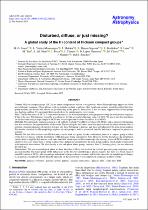| dc.contributor.author | Jones, Michael G | |
| dc.contributor.author | Verdes-Montenegro, Lourdes | |
| dc.contributor.author | Moldon, Javier | |
| dc.contributor.author | Damas-Segovia, Ancor | |
| dc.contributor.author | Luna-Valero, Sebastian | |
| dc.contributor.author | Borthakur, Sanchayeeta | |
| dc.contributor.author | Yun, M | |
| dc.contributor.author | del Olmo, Ascensión | |
| dc.contributor.author | Perea, Jaime | |
| dc.contributor.author | Cannon, John | |
| dc.contributor.author | Lopez Gutierrez, Diego | |
| dc.contributor.author | Cluver, Michelle | |
| dc.contributor.author | Garrido, Julián | |
| dc.contributor.author | Sanchez, S | |
| dc.date.accessioned | 2023-04-12T08:17:44Z | |
| dc.date.available | 2023-04-12T08:17:44Z | |
| dc.date.issued | 2023 | |
| dc.identifier.citation | Jones, M.G., Verdes-Montenegro, L., Moldon, J., Segovia, A.D., Borthakur, S., Luna, S., Yun, M., Del Olmo, A., Perea, J., Cannon, J. and Gutierrez, D.L., 2023. Disturbed, diffuse, or just missing?-A global study of the HI content of Hickson compact groups. Astronomy & Astrophysics, 670, p.A21. | en_US |
| dc.identifier.uri | https://doi.org/10.1051/0004-6361/202244622 | |
| dc.identifier.uri | http://hdl.handle.net/10566/8751 | |
| dc.description.abstract | Context. Hickson compact groups (HCGs) are dense configurations of four to ten galaxies, whose H I morphology appears to follow an evolutionary sequence of three phases, with gas initially confined to galaxies, then significant amounts spread throughout the intra-group medium, and finally with almost no gas remaining in the galaxies themselves. It has also been suggested that several groups may harbour a diffuse H I component that is resolved out by interferometric observations.
Aims. The H I deficiency of HCGs is expected to increase as the H I morphological phase progresses along the evolutionary sequence. If this is the case, H I deficiency would be a rough proxy for the age and evolutionary state of a HCG. We aim to test this hypothesis for the first time using a large sample of HCGs and to investigate the evidence for diffuse H I in HCGs.
Methods. We performed a uniform reduction of all publicly available VLA H I observations (38 HCGs) with a purpose-built pipeline that also maximises the reproducibility of this study. The resulting H I data cubes were then analysed with the latest software tools to perform a manual separation of emission features into those belonging to galaxies and those extending into the intra-group medium. We thereby classified the H I morphological phase of each group as well as quantified their H I deficiency compared to galaxies in isolation.
Results. We find little evidence that H I deficiency can be used as a proxy for the evolutionary phase of a compact group in either of the first two phases, with the distribution of H I deficiency being consistent in both. However, for the final phase, the distribution clearly shifts to high H I deficiencies, with more than 90% of the expected H I content typically missing. Across all HCGs studied, we identify a few cases where there is strong evidence for a diffuse gas component in the intra-group medium, which might be detectable with improved observations. We also classify a new sub-phase where groups contain a lone H I-bearing galaxy, but are otherwise devoid of gas.
Conclusions. The new morphological phase we have identified is likely the result of an evolved, gas-poor group acquiring a new, gas-rich member. The large spread of H I deficiencies in the first two morphological phases suggests that there is a broad range of initial H I content in HCGs, which is perhaps influenced by large-scale environment, and that the timescale for morphological changes is, in general, considerably shorter than the timescale for the destruction or consumption of neutral gas in these systems. | en_US |
| dc.publisher | EDP Sciences | en_US |
| dc.subject | galaxies: evolution | en_US |
| dc.subject | galaxies: groups: general | en_US |
| dc.subject | galaxies: interactions | en_US |
| dc.subject | galaxies: ISM | en_US |
| dc.subject | radio lines: ISM | en_US |
| dc.title | Disturbed, diffuse, or just missing? A global study of the H I content of Hickson compact groups | en_US |
| dc.type | Article | en_US |

